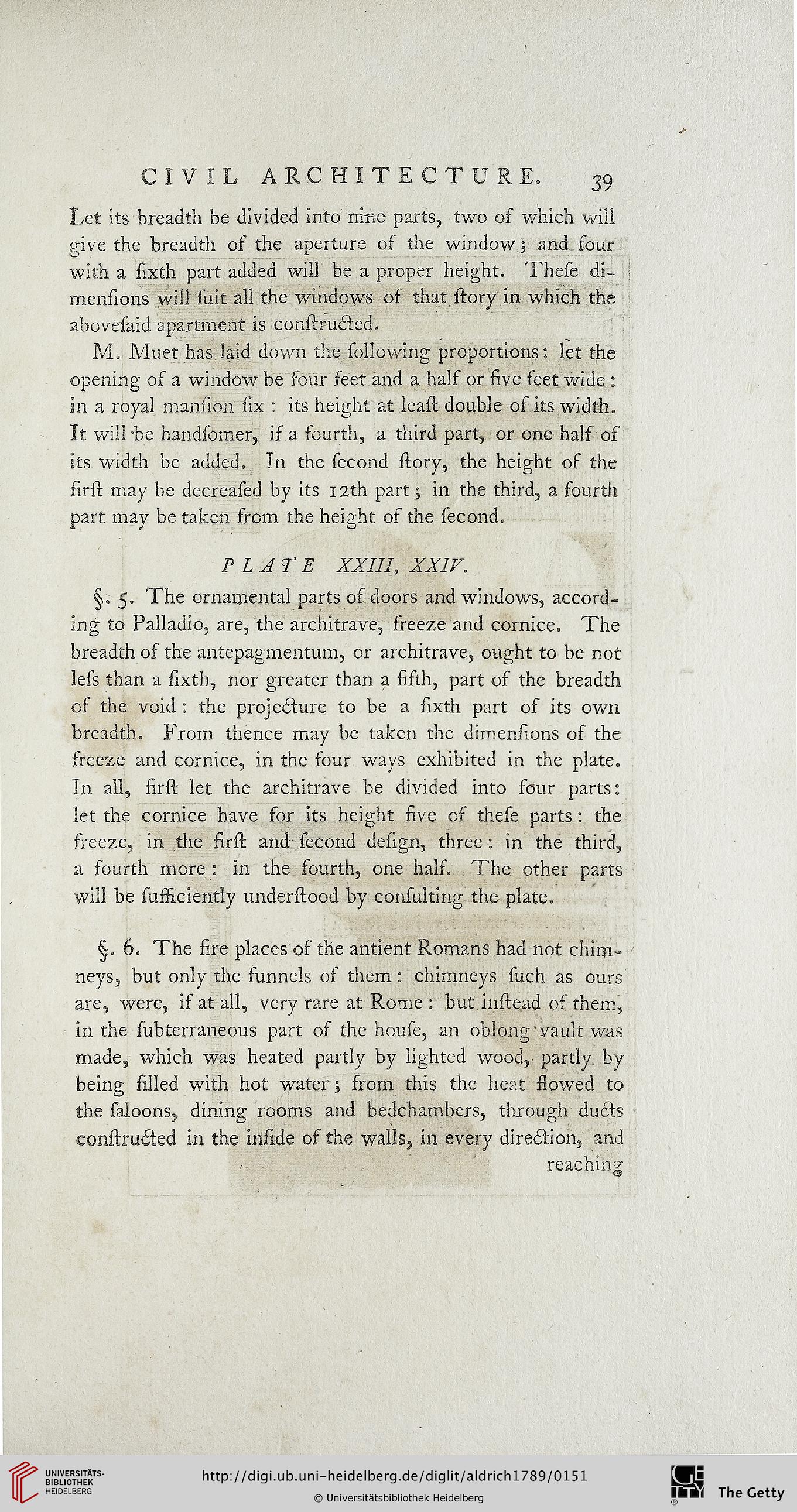CIVIL ARCHITECTURE.
39
Let its breadth be divided into nine parts, two of which will
give the breadth os the aperture of the window; and sour
with a sixth part added will be a proper height. These dt-
menfions will suit all the windows of that story in which the
abovesard apartment is construdted.
M. Muet has laid down the sollowing proportions: let the
opening of a window be sour seet and a half or five feet wide :
in a royal mansion six : its height at leas! double of its width.
It will -be handsomer, if a fourth, a third part, or one hals of
its width be added. In the second story, the height of the
strst may be decreased by its 12th part; in the third, a fourth
part may be taken from the height of the second.
PLATE XXIII, XXIV.
§. 5. The ornamental parts of doors and windows, accord-
ing to Palladio, are, the architrave, freeze and cornice. The
breadth of the antepagmentum, or architrave, ought to be not
lests than a sixth, nor greater than a fifth, part of the breadth
os the void : the projedture to be a sixth part of its own
breadth. From thence may be taken the dimensions of the
freeze and cornice, in the four ways exhibited in the plate.
In all, first let the architrave be divided into four parts:
let the cornice have for its height five of these parts: the
sreeze, in the first and second design, three : in the third,
a fourth more : in the fourth, one hals. The other parts
will be sufficiently understood by consulting the plate.
§. 6. The fire places of the antient Romans had not chim-
neys, but only the funnels of them : chimneys such as ours
are, were, if at all, very rare at Rome : but instead of them,
in the subterraneous part os the house, an oblong vault was
made, which was heated partly by lighted wood, partly, by
being filled with hot water; from this the heat ssowed to
the saloons, dining rooms and bedchambers, through ducts
construdted in the inside of the walls, in every diredtion, and
reaching
39
Let its breadth be divided into nine parts, two of which will
give the breadth os the aperture of the window; and sour
with a sixth part added will be a proper height. These dt-
menfions will suit all the windows of that story in which the
abovesard apartment is construdted.
M. Muet has laid down the sollowing proportions: let the
opening of a window be sour seet and a half or five feet wide :
in a royal mansion six : its height at leas! double of its width.
It will -be handsomer, if a fourth, a third part, or one hals of
its width be added. In the second story, the height of the
strst may be decreased by its 12th part; in the third, a fourth
part may be taken from the height of the second.
PLATE XXIII, XXIV.
§. 5. The ornamental parts of doors and windows, accord-
ing to Palladio, are, the architrave, freeze and cornice. The
breadth of the antepagmentum, or architrave, ought to be not
lests than a sixth, nor greater than a fifth, part of the breadth
os the void : the projedture to be a sixth part of its own
breadth. From thence may be taken the dimensions of the
freeze and cornice, in the four ways exhibited in the plate.
In all, first let the architrave be divided into four parts:
let the cornice have for its height five of these parts: the
sreeze, in the first and second design, three : in the third,
a fourth more : in the fourth, one hals. The other parts
will be sufficiently understood by consulting the plate.
§. 6. The fire places of the antient Romans had not chim-
neys, but only the funnels of them : chimneys such as ours
are, were, if at all, very rare at Rome : but instead of them,
in the subterraneous part os the house, an oblong vault was
made, which was heated partly by lighted wood, partly, by
being filled with hot water; from this the heat ssowed to
the saloons, dining rooms and bedchambers, through ducts
construdted in the inside of the walls, in every diredtion, and
reaching





